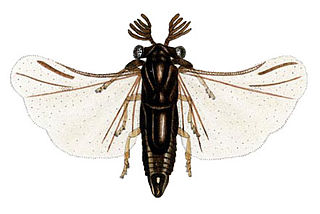
The Strepsiptera are an order of insects with eleven extant families that include about 600 described species. They are endoparasites of other insects, such as bees, wasps, leafhoppers, silverfish, and cockroaches. Females of most species never emerge from the host after entering its body, finally dying inside it. The early-stage larvae do emerge because they must find an unoccupied living host, and the short-lived males must emerge to seek a receptive female in her host. They are believed to be most closely related to beetles, from which they diverged 300–350 million years ago, but do not appear in the fossil record until the mid-Cretaceous around 100 million years ago.
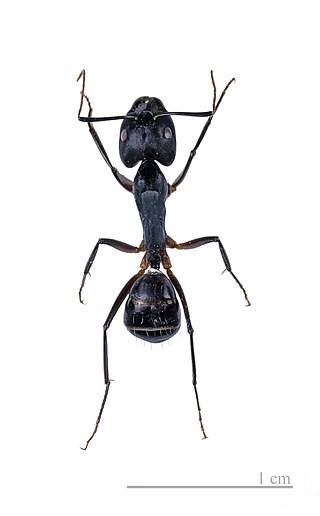
The Formicinae are a subfamily within the Formicidae containing ants of moderate evolutionary development.

Weevils are beetles belonging to the superfamily Curculionoidea, known for their elongated snouts. They are usually small – less than 6 mm in length – and herbivorous. Approximately 97,000 species of weevils are known. They belong to several families, with most of them in the family Curculionidae. It also includes bark beetles, which while morphologically dissimilar to other weevils in lacking the distinctive snout, is a subfamily of Curculionidae. Some other beetles, although not closely related, bear the name "weevil", such as the biscuit weevil, which belongs to the family Ptinidae.
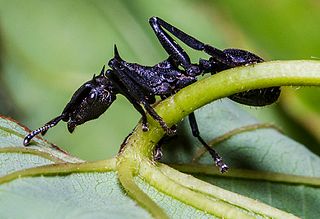
Cephalotes is a genus of tree-dwelling ant species from the Americas, commonly known as turtle ants. All appear to be gliding ants, with the ability to "parachute" and steer their fall so as to land back on the tree trunk rather than fall to the ground, which is often flooded.

Nothomyrmecia, also known as the dinosaur ant or dawn ant, is an extremely rare genus of ants consisting of a single species, Nothomyrmecia macrops. These ants live in South Australia, nesting in old-growth mallee woodland and Eucalyptus woodland. The full distribution of Nothomyrmecia has never been assessed, and it is unknown how widespread the species truly is; its potential range may be wider if it does favour old-growth mallee woodland. Possible threats to its survival include habitat destruction and climate change. Nothomyrmecia is most active when it is cold because workers encounter fewer competitors and predators such as Camponotus and Iridomyrmex, and it also increases hunting success. Thus, the increase of temperature may prevent them from foraging and very few areas would be suitable for the ant to live in. As a result, the IUCN lists the ant as Critically Endangered.

Sphecomyrma is an extinct genus of ants which existed in the Cretaceous approximately 79 to 92 million years ago. The first specimens were collected in 1966, found embedded in amber which had been exposed in the cliffs of Cliffwood, New Jersey, by Edmund Frey and his wife. In 1967, zoologists E. O. Wilson, Frank Carpenter and William L. Brown, Jr. published a paper describing and naming Sphecomyrma freyi. They described an ant with a mosaic of features—a mix of characteristics from modern ants and aculeate wasps. It possessed a metapleural gland, a feature unique to ants. Furthermore, it was wingless and had a petiole which was ant-like in form. The mandibles were short and wasp-like with only two teeth, the gaster was constricted, and the middle and hind legs had double tibial spurs. The antennae were, in form, midway between the wasps and ants, having a short first segment but a long flexible funiculus. Two additional species, S. canadensis and S. mesaki, were described in 1985 and 2005, respectively.
Zophotermes is an extinct genus of termite in the Isoptera family Rhinotermitidae known from two Eocene fossils found in India. The genus contains a single described species, Zophotermes ashoki placed in the subfamily Prorhinotermitinae.
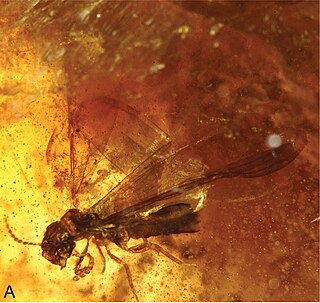
Nanotermes is an extinct genus of termites in the Isoptera family Termitidae known from only one Eocene fossil found in amber of the Cambay Basin. The genus contains a single described species, Nanotermes isaacae placed tentatively in the subfamily Termitinae.

Agroecomyrmecinae is a subfamily of ants containing two extant and two fossil genera. The subfamily was originally classified in 1930 by Carpenter as Agroecomyrmecini, a Myrmicinae tribe. Bolton raised the tribe to subfamily status in 2003, suggesting that Agroecomyrmecinae might be the sister taxon to Myrmicinae. It has since been discovered to be one of the earliest lineages of ants, a clade from the basal polytomy for all ants. In 2014, the subfamily was expanded to two tribes. The tribe Ankylomyrmini was moved from the subfamily Myrmicinae to Agroemyrmecinae.

Tatuidris, or armadillo ant, is a rare genus of ants consisting of a single species, Tatuidris tatusia. The ants are small in size and inhabit the leaf litter of Neotropical forests in Central and South America, from Mexico to Brazil. Workers are ferruginous-colored to dark red and present a distinctive morphology, consisting of a shield-like head with a broad vertex, ventrally-turned heavy mandibles which do not overlap at full closure, and unique among ants – an antenna socket apparatus sitting upside-down. Little is known about the biology of the ants, but they are likely nocturnal and specialist predators.

Agroecomyrmex is an extinct genus of ants in the formicid subfamily Agroecomyrmecinae, for which it is the type genus. The genus contains a single described species, Agroecomyrmex duisburgi. Agroecomyrmex is known from a group of Middle Eocene fossils which were found in Europe.

Zigrasimecia is an extinct genus of ants which existed in the Cretaceous period approximately 98 million years ago. The first specimens were collected from Burmese amber in Kachin State, 100 kilometres (62 mi) west of Myitkyina town in Myanmar. In 2013, palaeoentomologists Phillip Barden and David Grimaldi published a paper describing and naming Zigrasimecia tonsora. They described a dealate female with unusual features, notably the highly specialized mandibles. Other features include large ocelli, short scapes, 12 antennomeres, small eyes, and a clypeal margin that has a row of peg-like denticles. The genus Zigrasimecia was originally incertae sedis within Formicidae until a second species, Zigrasimecia ferox, was described in 2014, leading to its placement in the subfamily Sphecomyrminae. Later, it was considered to belong to the distinct subfamily Zigrasimeciinae.

Azteca alpha is an extinct species of ant in the subfamily Dolichoderinae known from possibly Miocene fossils found on Hispaniola. A. alpha is one of only two species in the genus Azteca to have been described from fossils, both found in Dominican amber. It is the host for a fossil nematode, and has been preserved with scale insects.

Usomyrma is an extinct genus of ant in the formicid subfamily Dolichoderinae. The genus contains a single described species, Usomyrma mirabilis, that is known from two Middle Eocene fossils which were found in Scandinavian amber in Denmark.

Many species of Staphylinidae have developed complex interspecies relationships with ants, known as myrmecophily. Rove beetles are among the most rich and diverse families of myrmecophilous beetles, with a wide variety of relationships with ants. Ant associations range from near free-living species which prey only on ants, to obligate inquilines of ants, which exhibit extreme morphological and chemical adaptations to the harsh environments of ant nests. Some species are fully integrated into the host colony, and are cleaned and fed by ants. Many of these, including species in tribe Clavigerini, are myrmecophagous, placating their hosts with glandular secretions while eating the brood.
Aneuretellus is an extinct genus of ant in the formicid subfamily Aneuretinae, and is one of eight genera of the subfamily. The genus contains a single described species Aneuretellus deformis and is known from one Middle Eocene fossil which was found in Sakhalin in the Russian Far East.
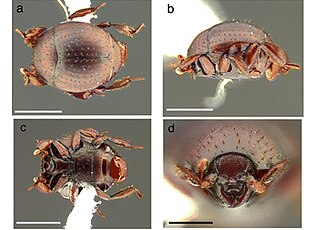
Nymphister kronaueri is a species of histerid beetle native to Costa Rica. It was first discovered in 2014. The discovery of the beetle received much media attention due to its unusual habit of hitchhiking on army ants. It was formally described in 2017.

Aphaenogaster dlusskyana is an extinct species of ant in the subfamily Myrmicinae known from a single Middle Eocene fossil found in amber on Sakhalin. At the time of description A. dlusskyana was one of eight ant species known from Sakhalin fossil.
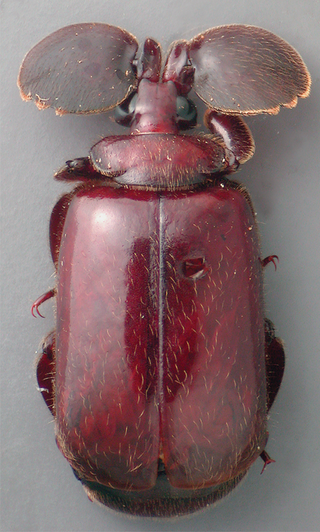
Platyrhopalopsis melleii is a species of ant-nest or flanged bombardier beetle found in southern India. They live inside the nests of ants of the genus Carebara and adults are only rarely seen in the open, most often at night when they get attracted to lights.
















